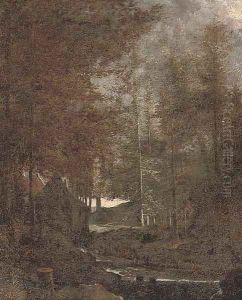Albert Van Everdingen Paintings
Albert van Everdingen was born in 1621 in Alkmaar, Netherlands, and died in 1675 in Amsterdam. He was a Dutch Golden Age painter and printmaker, known for his landscapes, seascapes, and portrayal of Scandinavian forests and waterfalls. Van Everdingen's artistic journey began in his hometown of Alkmaar, but his style and thematic preferences were significantly influenced by his travels, particularly to Norway and Sweden in the mid-1640s. These travels marked a pivotal point in his career, as the majestic landscapes of Scandinavia deeply inspired him, leading to the creation of a body of work that distinguished him from his contemporaries.
Van Everdingen studied under Roelandt Savery in Utrecht and Pieter de Molijn in Haarlem, which helped him develop a robust foundational skill in painting and printmaking. His early works showed a tendency towards marine and river scenes, reflecting the influence of his teachers and the Dutch landscape tradition. However, after his Scandinavian journey, his work took a distinctive turn towards capturing the rugged beauty of the northern wilderness, a theme that would become synonymous with his name.
Albert van Everdingen played a significant role in the development of Dutch landscape painting, moving away from the idyllic and pastoral scenes common among his peers to embrace the more untamed and dramatic aspects of nature. His use of dramatic lighting and keen attention to textural details helped create a sense of depth and realism in his landscapes, which were both admired and sought after by collectors of the time.
In addition to his oil paintings, Van Everdingen was a master printmaker, utilizing etching and mezzotint techniques to reproduce the grandeur of his landscapes. His prints played a crucial role in spreading his fame beyond the borders of the Netherlands, influencing the portrayal of nature in European art.
Albert van Everdingen's legacy extends beyond his contributions to landscape painting. He was also involved in the decoration of several prominent buildings, including the Oranjezaal in Huis ten Bosch Palace in The Hague, showcasing his versatility as an artist. Despite his death in 1675, Van Everdingen's work continues to be celebrated for its pioneering depiction of natural landscapes, marking him as a significant figure in the history of Dutch art.
